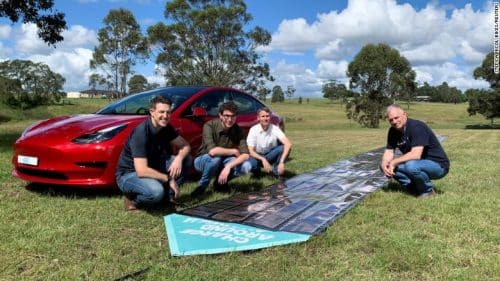A group of scientists from Newcastle University will hit the road in an off-grid Tesla fueled by 18 printed solar panels in September.
The Charge Along Australia project is a 15,100 Kilometer trek around Australia’s coast to show how printed solar technology may be utilised to create renewable energy for off-grid electric car charging while simultaneously increasing climate change awareness. It is a partnership between the UK company Charging Around Britain Ltd and the University of Newcastle’s Centre for Organic Electronics.

Professor Paul Dastoor and his colleagues at the University of Newcastle’s Centre for Organic Electronics were among the first to develop a water-based solar paint that can be printed at fast speeds to build huge regions using roll-to-roll manufacturing processes. Organic photovoltaics (OPV), a cutting-edge solar technology, is used in the printed panels, which are each 18 metres long. According to the researchers, OPV technology, also known as plastic cells, will play a significant role in the future of renewable energy.
“These low-cost, printed solar modules offer immense potential as a lightweight, easily installed alternative to conventional, silicon-based solar panels, which are heavy and cumbersome. Envisage a future where the surface of every building or mode of transport could incorporate printed solar technology to generate power.”
During the journey, the team will be able to collect free solar energy from the sun along wilderness regions where there are no established EV charging stations. When the Tesla needs to be charged, the panels can be rolled out alongside it to absorb sunshine.
The goal is to eliminate the “range anxiety” that is now associated with long-distance electric vehicle use. The team’s larger purpose, however, is to raise public awareness about the benefits of solar energy and its influence on climate change. “This is actually an ideal test bed to give us information about how we would go about using and powering technology in other remote locations, for example, in space,” said Professor Dastoor.







